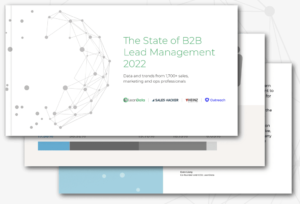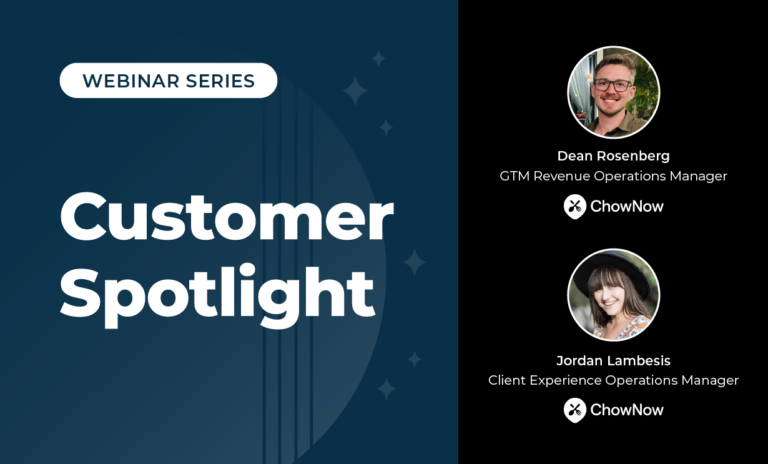Business has been forever changed by the events of the last few years. Remote work is no longer just an idea, streamlining processes has become even more important, and the speed at which we work has become paramount.
Revenue leaders are acutely aware of the importance of speed to lead. But, there doesn’t seem to be a consistency to what we consider speed. What one business thinks is a great lead response time to a demo request may be exponentially longer than their peers. And, that doesn’t take into account the efficiency needed or the quality of the response.
This is why LeanData built out the 2022 State of B2B Lead Management report. Collaborating with Sales Hacker, Heinz Marketing, and Outreach, we surveyed over 1,700 sales, marketing, and operations professionals about their lead management processes, crunched some numbers, and are happy to report our findings.
 Results were released on April 12th in an exclusive conversation between the experts that created the survey: Mary Shea (Outreach’s Global Innovation Evangelist and former Forester Analyst), Matt Heinz (President of Heinz Marketing), and Doug Bell (CMO at LeanData). You can view the recording here.
Results were released on April 12th in an exclusive conversation between the experts that created the survey: Mary Shea (Outreach’s Global Innovation Evangelist and former Forester Analyst), Matt Heinz (President of Heinz Marketing), and Doug Bell (CMO at LeanData). You can view the recording here.
But, since you are already on this page, let’s go through some of what was discussed:
Revenue Leaders clearly want more automation, but do they need it?
Mary Shea (6:15): “What I see in the organizations that I work with and advise is that two different types of problems. One is they have a number of duplicated point solutions that are in place. So it’s not cost effective, there’s too much time and effort spent managing multiple vendors, and they don’t have a single source of truth in terms of their ability to capture a robust data set. Then, on the other end of the spectrum, you have organizations where significant gaps in terms of technology that could really be transformational to helping their sellers be more effective and deliver a better buying experience.”
Matt Heinz (7:50): “What was adequate, maybe a couple of years ago, is not sufficient today. And I think sometimes we’re focused on the wrong behavior and the wrong outcome from that. Lead routing used to be as simple as, ‘Oh, just make sure that we get to a salesperson, make sure that we can do faster sales follow up, make sure that there’s a process or a sequence of things they can follow up.’ I actually think, for companies that have answered that ‘our lead experience, our lead management is fine,’ or that they’re okay with it, I think half of those folks are sort of blissfully uninformed.”
Doug Bell (15:34): “One thing that struck me was when we asked revenue leaders what their priorities were heading into 2022. Everybody said, ‘We want automation.’ That was huge; obviously a huge priority. But then when you ask them, ‘What are you going to be looking to do in 2022?’, in terms of actions you’re going to take, number five was adding a new tool to stack. And I thought, that’s really interesting, right? Leaders are saying ‘we need more automation, but I’m not looking to add new tools to the stack per se.’ So my takeaway there was that this idea of automation is about making all these things work better together, as opposed to yet another tool in the RevTech stack. I think they need better connections between the people, the processes, and the systems to make stuff happen.”
Speed is nothing without accuracy, but when does speed matter and when does speed kill?
MH (9:05): “Too often, we look at this as a lead management exercise, as opposed to a prospect experience opportunity … What is the right prospect experience? Like, how do I want to be treated as a prospect? I should know that other people in my organization have already engaged with your company, right? Or, if I download a white paper, I don’t need a two-minute response time on my lead. Like I got my white paper; I’m good dude … If you call right away, that might be counterproductive, versus making sure that you’re calling with the right message with the right context, offering additional value based on what you know about what I did.”
MH (23:50): “It’s not just speed to response, it’s speed to access of information … That said, your responsiveness as a sales team, your ability to get back to someone based on something you see, may or may not create the best prospect experience. Speed is not as important as context and value … You don’t want to call and say, “Hey, thanks for downloading the white paper. Would you like to see a demo?” Like no one ever answers yes to that? Or, you know, don’t ask people what keeps them up at night? Tell them what should keep them up at night … Which of these just made you sweaty thinking about it? Because it’s pressing and right now, which of these were you not thinking about? But, now that you know all of your peers are thinking about it, would you like to know more about why?”
MH (25:00): “If you’re doing a multi-month or multi-quarter sales cycle, the ‘next five minute’ response isn’t as important as making sure you’ve got the right level of next steps, the right richness of information to earn ongoing attention and commitment from that prospect.”
MS (25:33): “When you think about today’s buyers, they don’t want tradeoffs or an either/or. They want everything right. And they want that because of the rich consumer experiences they have and all the marketplaces out there that we know and use so much ourselves. So, they want it all … I love this idea about instantaneous access … you’ve got people all over the world at any moment in time where they’ve got an itch that they need to scratch on an opportunity or problem. And they go to your site, they go to your content, they go to your peer review sites, what have you, and they need to find that information instantaneously. And if they don’t, the attention spans are so short right now, it’ll just go to the next pipe … If you’re a seller, and you’re going to make some sort of an outreach, it better damn well have meaning to it, have insights that are part of it, have a high degree of customization and personalization. If you prioritize speed over quality, that’s going to really hurt you in terms of the sales cycle.”
Are lead-centric models a thing of the past, and when is it time to consider a shift to opportunity and account-centered models?
MS (33:49) “One of the big things that I’m seeing that is going to accelerate adoption of more of an account/opportunity-based approach. And you’re seeing that across the board … more and more stakeholders involved. Many of them are distributed; oftentimes they’ve got completely different agendas. Then you have a consensus building model to make the decision. And then, you’ve got your CFO and Procurement that are weighing in more and more as the economic environment becomes more and more volatile. So, it’s almost like unless you’re taking an account- or opportunity-based approach, I just don’t know how you manage the scope of buying decisions these days.”
MH (35:14) “The smart companies are putting a focus on the account for a couple reasons. One, they understand that not all accounts are equal, that we need to understand: there’s my addressable market; there’s my target market; there’s the market that’s my maybe ready-to-buy based on a problem they have right now. So that level of precision is important … But, it’s still talking to people, and sometimes you’ll get a group call. But, oftentimes, as a sales rep … you’re just talking to one person. So it is a lead, but you have to understand the context in which that lead exists. And the relationship that individual has, actually the other people at that account have, and the history of people in that account have with your organization.”
Benchmark, learn and take forward action
Revenue stack automation. Speed, accuracy, efficiency. Account-centric approaches. None of these things are easy, nor are there silver bullets to solve these problems. But, you can start simple:
- Review your current processes. Do they match your strategy? Do they match your current stack and staffing?
- Audit your tech stack. Are you getting what you need? Are you using that for which you are pay? Are there duplicative actions between tools?
- Consolidate where possible. Less sprawl makes for more consistency, greater speed, and better customer experiences
- Get a better view into account-level data. Connecting that inbound lead to an active account gives you access to the full history and creates a shared awareness and clear accountability on every signal, play, and process.
- Bring in a partner when needed. Sometimes we all need help to get our stacks aligned and a trusted partner can help ensure you are working with precision AND speed.
Y’all, these are huge topics that are being discussed around the industry, and we could have spent more than an hour on each. Thank you so much to Mary, Matt, and Doug for taking the time to join us and share your thoughts.
So what now?
- Make sure to watch the recording of the webinar for even more insights from our experts.
- Download the brand new The State of B2B Lead Management 2022 report to see all of the other amazing things we learned.
- Take a look at our infographic Sales Stack Essentials to Increase Speed to Lead and see how the right tooling can optimize your entire customer experience.








